PART 1- Hussein Exam 1
1/52
Earn XP
Description and Tags
based ONLY off STUDY GUIDE!!!!!!!!!!
Name | Mastery | Learn | Test | Matching | Spaced |
|---|
No study sessions yet.
53 Terms
What’s the difference between pasteurization and sterilization?
pasteurization- kill common pathogens
sterilization- kill ALL living microorganisms, spores, and viruses
Match the organism to its infectious disease:
Organism | Infectious Disease |
Animal (parasite) | |
Bacterial | |
Fungal | |
Protozoal | |
Viral |
Disease options: HIV-AIDs, Influenza, Athlete’s foot, malaria, tuberculosis, wuhan coronavirus, schistosomiasis (trematode), syphilis
Organism | Infectious Disease |
Animal (parasite) | Schistosomiasis (trematode) |
Bacterial |
|
Fungal | Athlete’s foot |
Protozoal | Malaria (parasite) |
Viral |
|
What are Koch’s 4 postulates?
The cultured organism should cause disease when introduced into a healthy animal
The organism must be found in all animals suffering from the disease, but not in healthy animals
The organism must be isolated from a diseased animal and grown in pure culture
The organism must be re-isolated from the experimentally infected animal
Yeast/Fungi have what kind of cell walls? Do they have organelles? What size are their ribosomes?
CHITIN CELL WALLS
yes organelles, like mitochondria
80S ribosomes
Answer the following about Prokaryotes and Eukaryotes:
Prokaryotes | Eukaryotes | |
Members | ||
Nucleus? | ||
Haploid or Diploid? | ||
Ribosome size | ||
Organelles? |
Prokaryotes | Eukaryotes | |
Members | bacteria |
|
Nucleus? | NO | YES |
Haploid or Diploid? | Haploid | Diploid |
Ribosome size | 70S (30S,50S) | 80S (40S,60S) |
Organelles? | NONE | Yes—> ER, golgi, mito |
Do prokaryotes or eukaryotes have linear DNA, specialization, compartmentalization, mitosis/meiosis, and tissue/organ systems?
eukaryotes
Fill in the following table comparing G+ and G- bacteria:
Gram + | Gram - | |
Cell Wall/ Peptidoglycan thickness | ||
Outer membrane? | ||
Gram Stain Color | ||
Endotoxins/LPS? |
Gram + | Gram - | |
Cell Wall/ Peptidoglycan thickness | Thick | Thin |
Outer membrane? | Absent | Present |
Gram Stain Color | Purple | Pink/Red |
Endotoxins/LPS? | Absent | Present |
What are the steps of a Gram stain and how do you interpret the results?
Stain with purple (“crystal violet”)
Modify with KI (potassium iodide)
decolorize with alcohol
counterstain with red (“safranin”)
RESULTS
GRAM + REMAIN PURPLE
GRAM - BECOME PINK
What are the steps of an acid-fast stain and how do you interpret the results?
stain with red (“carbol-fuchsin”)
decolorize with acid alcohol
counterstain with methylene blue
RESULTS
Acid-fast REMAIN RED
Others become BLUE
Which of the following has cell walls made of peptidoglycan?
a. plants
b. animals
c. bacteria
d. fungi
c
What are the monomers for peptidoglycan cell walls?
NAG-NAM Pentapeptide monomers
NAG-NAM Pentapeptide monomers are what type of monomer?
amino sugars
What is the function of a peptidoglycan cell wall in bacteria?
PREVENT osmotic lysis
What’s the difference between Gram + and Gram - bacteria in terms of the tetrapeptides that link together the peptidoglycan?
Gram +
peptide bridge cross links Lys to D-Ala
tetrapeptide would be: L-Ala-D-Gln-L-Lys-D-Ala
Gram -
DAP cross-links directly to D-Ala
tetrapeptide would be: L-Ala-D-Glu-meso-DAP-D-Ala
What is the function of bactoprenol?
carrier molecule/transporter for peptidoglycan monomers made in the cytosol
What are the 4 shapes of bacteria?
cocci (round)
rods
spiral
vibrio (comma)
Pentaglycine is found in Gram ____________ cell walls.
a. negative
b. positive
b
What is the best kind of antibacterial drug?
what ribosomes does it inhibit?
what else does it inhibit?
best kind of abx—>
inhibits 30S, 50S, or 70S ribosomes (aka the ones in bacteria)
a drug that INHIBITs peptidoglycan synthesis
Does this describe gram - or gram + bacteria?
bacteria with 2 phospholipid bilayers, thin peptidoglycan wall, and has LPS
gram -
Does this describe gram - or gram + bacteria?
bacteria with thick peptidoglycan wall and teichoic and lipoteichoic acids
gram +
Where are teichoic acid and lipoteichoic acid found? function?
(not in the sg, i added in case)
Teichoic acid—> extends through cell wall—> trigger innate immune response, activate complement
Lipoteichoic acid—> attached to lipids of the cell membrane—> adhesion/penetration of host cells, resistance to phagocytosis
What are Polymyxins antibiotics used for? Why?
for topical infections with GRAM - BACTERIA—> bc polymyxins disrupt bacterial membranes and the outer membrane on Gram - bacteria is easily accessible
What are the 4 phases of the bacterial growth curve?
lag phase (“getting comfy”, making new enzymes, no bacteria growth yet)
log phase (exponential growth, most sensitive to drugs/radiation here)
stationary phase (death rate= division/growth rate)
death phase (death>division)
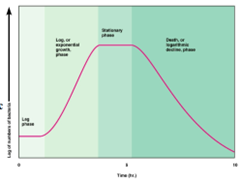
Beta-lactam antibiotics like penicillin work by inhibiting what enzyme? What phase of the bacterial growth curve are they most effective?
inhibit transpeptidase, most effective during EXPONENTIAL growth phase of bacteria
What type of bacteria completely lack the enzymes catalase and hydrogen peroxide dismutase?
a. facultative anaerobes
b. obligate anaerobes
c. microaerophiles
d. obligate aerobes
e. aerotolerant anaerobes
b. obligate anaerobes
What type of bacteria can live with or without O2?
a. facultative anaerobes
b. obligate anaerobes
c. microaerophiles
d. obligate aerobes
e. aerotolerant anaerobes
a. facultative anaerobes
What are capnophiles?
Thrive in high CO2 concentrations, and either require/tolerate oxygen
Bacteria can be classified based on their optimal temperature. What are the 4 types of bacteria and their optimal temperatures?
mesophile (35° and 38°C)- most common
psychrophile (cold 4°C)
thermophile (hot above 50°C)
hyperthermophile (hot springs above 80°C)
For EACH of the following processes, what is the final/terminal electron acceptor?
aerobic respiration
anaerobic respiration
glycolysis
fermentation
aerobic respiration- O2
anaerobic respiration- inorganic molecule
Sulfate reducers take (SO4-2) —> H2S
Nitrate reducers take (NO3-) —> NO2- —> NO—> N2
glycolysis- NAD+—> NADH
fermentation- organic molecule
What is the end product of glycolysis under AEROBIC conditions? How much is made by one glucose molecule?
pyruvate is the end product, 1 Glucose= 2 pyruvate
Substrate level phosphorylation is a type of ATP production that involves direct phosphate transfers and generates how much ATP in glycolysis and the TCA?
2 in glycolysis, 2 in TCA, 4 total
What is the total NADH molecules produced from the metabolism of one glucose molecule?
10
What is the molecule produced from glucose that enters the TCA?
acetate from acetyl-CoA
Which of the following is NOT an end product of fermentation?
a. acetic acid
b. lactate
c. ethanol/ ethyl alcohol
d. citrate
d
Fermentation uses substrate level phosphorylation to generate ___ ATP.
a. 1
b. 2
c. 3
d. 4
b
What is fermentation? What is it important in?
fermentation is the anaerobic breakdown of carbs
important in vigorous exercising muscle, milk fermenting bacteria
What is the net ATP yield of aerobic respiration? What is the net ATP yield of anaerobic respiration?
(not in the sg, but I thought add)
aerobic—>38 ATP
anaerobic—> ≤ 36 ATP
Fastidious bacteria need what?
many supplements needed in their growth medium (can’t just have a simple medium, ex in picture)
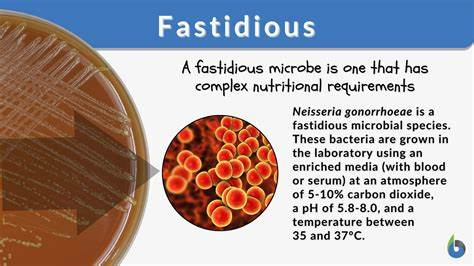
What are the 4 genetic transfer mechanisms?
transformation
conjugation
R-plasmids
transduction
Answer the following about Transformation:
What type of DNA is up taken by the bacteria? Describe it.
It is susceptible to what? why?
What experiment discovered bacterial transformation?
Competence to take up the DNA can be natural or _________.
naked DNA- DNA released from dead/lysed cells into environment
susceptible to NUCLEASES—> bc naked DNA is fragile/easily degraded by nucleases
GRIFFITH’s EXPERIMENT- discovered bacterial transformation
competence can be natural or artificial
What does natural and artificial competence refer to regarding transformation?
natural- ability of bacteria to take up DNA
artificial- permeability results from heat/cold shock
(wouldn’t normally take up DNA)
If I chill a bacteria with cations like CaCl2, that would be __________ competence.
a. natural
b. artificial
b
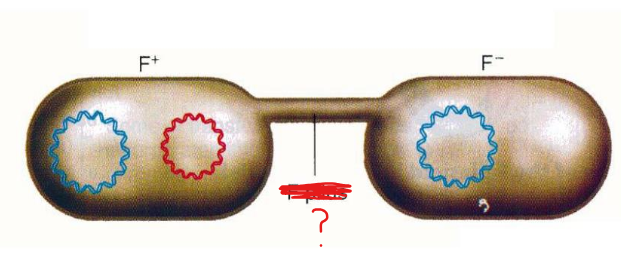
Conjugation is direct cell-to-cell transfer of DNA through a___________________.
F-pilus/ conjugation bridge
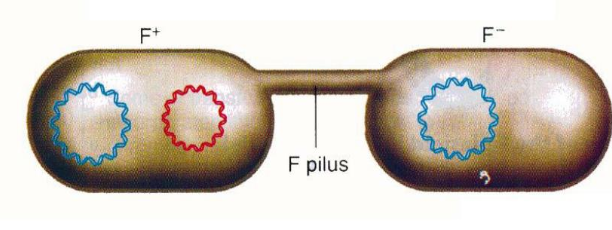
What is a small circular piece of DNA that carries genes for conjugation?
Fertility plasmid/ F plasmid
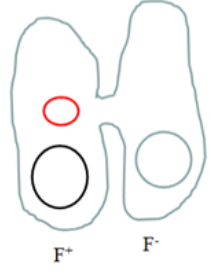
An F+ bacteria conjugates with a F- bacteria. What is the result?
sex change—> F- bacteria turns F+
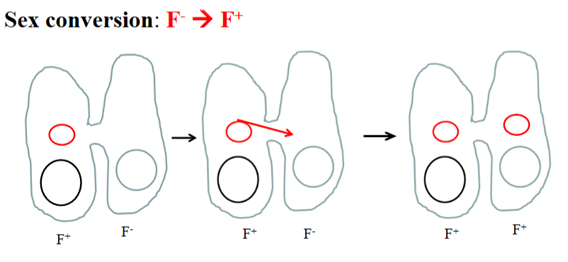
What are Hfr cells in terms of conjugation?
they have an INTEGRATED F factor into its chromosome (instead of having it as a separate plasmid like in F+)
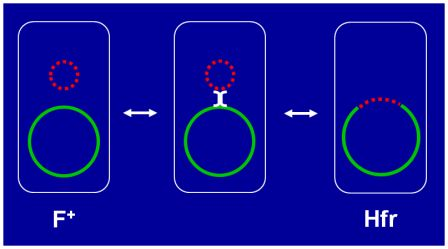
With which of the following has a transfer of chromosomal genes?
SATA:
a. F+
b. F-
c. Hfr
d. F’
c,d —> both involve transfer of chromosomal genes
(Hfr transfers more than F’)
An F’ bacteria conjugates with a F- bacteria. What is the result?
sex change—> F- bacteria turns F’
What are R plasmids? What bacteria is an example of a bacteria with R-plasmids?
R-plasmids (resistance plasmids) are extrachromosomal DNA molecules that carry antibiotic resistance genes
ex: Salmonella
λgt11 uses ____________ transduction to introduce genes into bacteria.
a. generalized
b. specialized
b
Answer the following about transduction:
what organism does it use to transfer genes?
What is made when a bacteriophage integrates into the bacterial DNA? What is that process called?
What is the role of suppressor proteins?
uses BACTERIOPHAGES
PROPHAGES are made during LYSOGENY (when the bacteriophage is integrated into the bacteria DNA)
role—> how the bacteriophage stays integrated into bacteria DNA
What are the 2 types of transduction?
generalized transduction (ad random integration of phage and donor genes in the chromosome; lytic cycle)
specialized transduction (integrate in certain site on the recipient chromosome: lytic or lysogeny)
Virulence factors are molecules or structures that help bacteria evade the immune system. What are two examples of virulence factors? Which is commonly used by meningitis bacteria?
IgA protease
Capsule (used by meningitis bacteria)